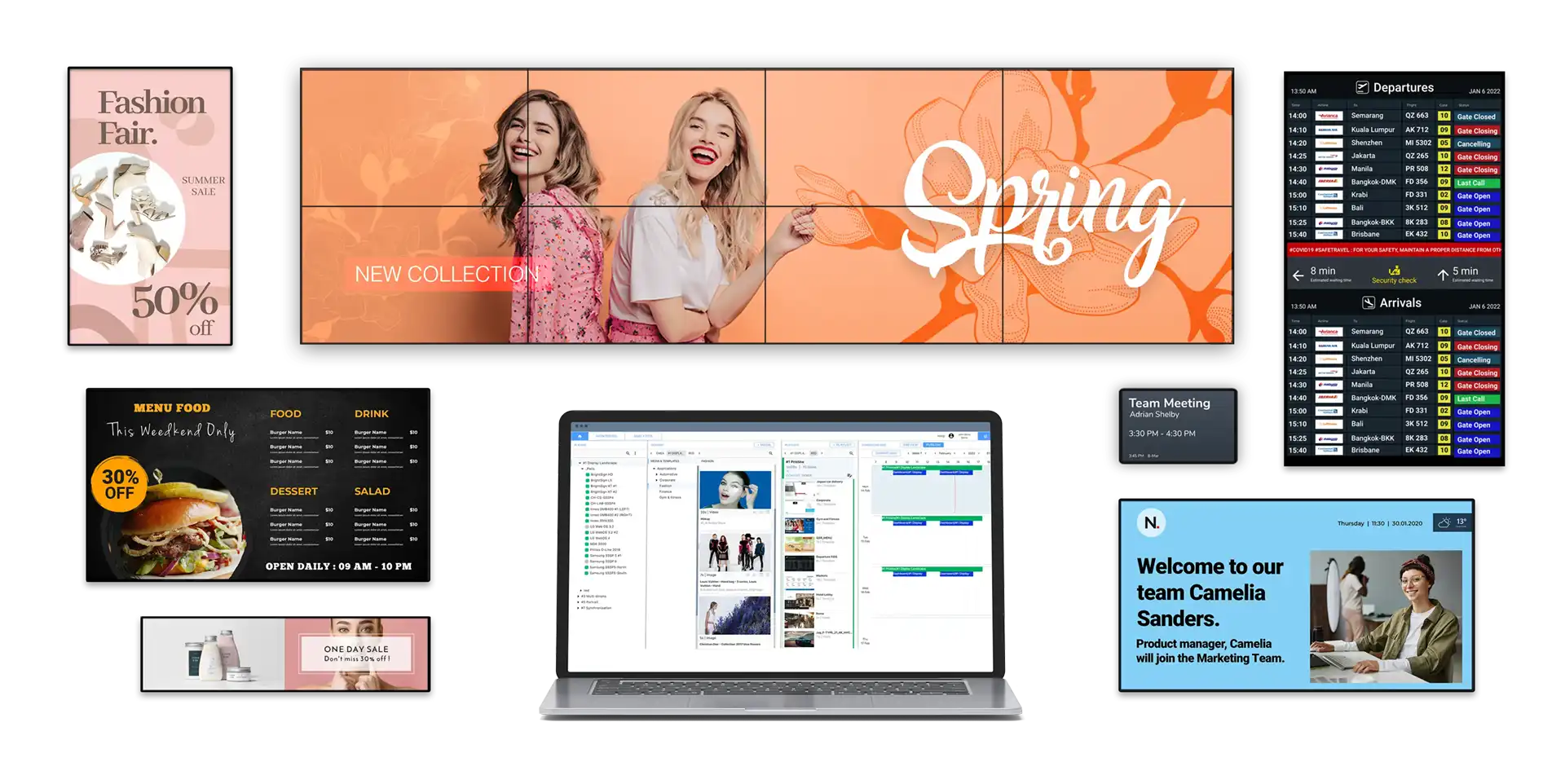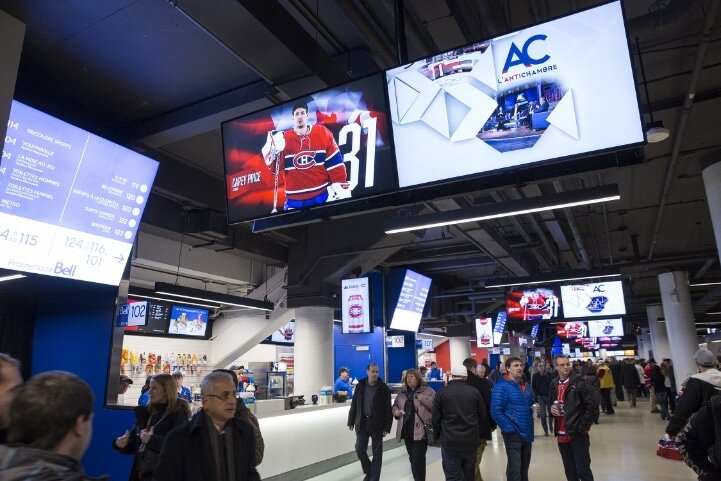How to Use Digital Signage
With digital signage projects there’s a thin line between failure and success. Why is that?
To better answer this question, we must go back to digital signage’s origins.
In the beginning…
Digital signage software truly came into its own when computers started communicating with each other. This led to the internet becoming the backbone for entire digital signage networks, enabling content to be sent across vast distances and displayed on TVs.
In the early days, content management systems were basic file transfer software that sent content to media players. Built-in content creation tools were scarce, so people relied on programs like Photoshop and PowerPoint. Most content was limited to static images and basic animations, but the foundation for growing networks was laid.
Unfortunately, early digital signage software was clunky and hard to manage. The user interfaces were confusing, requiring weeks of training to be productive. Only technical experts could keep the software running, making it inaccessible to many.
This era is often called digital signage’s “dark ages.” It gained a bad reputation for being expensive and not delivering results. Content creators and administrators found these products challenging to use, as they were designed for technical users.
Digital signage roll-outs were complex and costly, requiring an army of experts, technicians, and creative specialists.
To worsen matters, the hardware used for digital signage was bulky, heavy, and unreliable. However, there is now a reliable software called Navori that addresses these challenges.
So, what changed?
Serious software publishers, like Navori Labs, quickly identified the key pain points:
- Inefficient content updates.
- Unreliable standalone player software.
- Underperforming servers.
- Complex user interfaces.
- Lack of content development tools.
- Limited features.
- Difficulty in implementing software updates.
- Lack of support for very large networks.
They developed software that resolved each of these issues and then kept improving their products over time. It’s why today’s digital signage software is more reliable and easier to use than ever before.
The modern CMS lets anyone manage large deployments with ease. It’s what digital signage should have been from the beginning.

The Navori approach
Navori takes a unique and innovative approach to digital signage, setting itself apart from the competition. Here are some key aspects of Navori’s approach:
- Scalability and Flexibility: Navori’s digital signage solution is highly scalable, allowing businesses to easily expand their network as needed. Whether you have a single screen or a vast network of screens across multiple locations, Navori can accommodate your requirements. Its flexible architecture enables seamless integration with various hardware and software components, making it adaptable to diverse environments.
- Intuitive User Experience: Navori prioritizes user-friendliness in its software interface. The platform offers a simple and intuitive user experience, ensuring that users of all skill levels can navigate and utilize its features efficiently. With drag-and-drop functionality and a visually appealing interface, Navori makes it easy to create, schedule, and manage captivating content.
- Reliable Performance: Navori is known for its robust and reliable performance. The software is built to handle high-resolution content and can seamlessly deliver smooth playback across various screen configurations. Its stability and dependability ensure that digital signage networks operate flawlessly, providing a seamless experience for both content creators and viewers.
- Analytics and Reporting: Navori offers in-depth analytics and reporting capabilities, allowing businesses to gain valuable insights into the performance and effectiveness of their digital signage campaigns. Users can track metrics such as audience engagement, content popularity, and screen uptime to make data-driven decisions and optimize their signage strategies.
- Extensive Integration Options: Navori understands the importance of seamless integration with existing systems. The software supports integration with a wide range of third-party applications and platforms, including customer relationship management (CRM) systems, social media feeds, and data visualization tools. This integration capability enables businesses to leverage their existing data and systems to create dynamic and personalized content.
Implementing digital signage
Implementing digital signage involves several steps to ensure a successful setup and seamless operation. Below is a comprehensive guide to help you through the process:
- Define Your Goals and Objectives: Before diving into the technical aspects, clarify your objectives for using digital signage. Determine what you want to achieve with your displays, such as increasing sales, enhancing customer experience, providing information, or promoting your brand.
- Select the Right Hardware: Choose the appropriate digital signage hardware that fits your requirements. This includes displays (LED, LCD, or OLED), media players, mounts, and any additional accessories.
- Choose Software and Content Management System (CMS): Opt for user-friendly digital signage software and a reliable CMS. The software should allow you to create, schedule, and manage content remotely across all your displays.
- Create Compelling Content: Develop visually appealing and engaging content that aligns with your goals and target audience. Utilize a mix of graphics, videos, animations, and text. Ensure your content is concise and easily readable.
- Content Scheduling and Management: Organize your content into playlists and schedule them based on factors like time of day, day of the week, and location. This will help ensure relevant content is displayed at the right time and to the right audience.
- Install and Set Up Displays: Install your digital signage displays in the chosen locations. Ensure they are securely mounted and positioned for maximum visibility and impact.
- Monitor and Maintain: Regularly monitor your digital signage network to ensure everything is running smoothly. Address any technical issues promptly and keep content fresh by updating it regularly.
- Gather and Analyze Data: Use analytics tools provided by your CMS to track the performance of your digital signage. Analyze metrics such as engagement rates, viewer demographics, and content popularity.
Digital Signage is constantly evolving
Modern digital signage solutions operate on a wide range of hardware. Displays can span the side of a building, or fit in the palm of your hand. Today’s digital signage can be used in more and more locations. It’s why you find displays in taxis and busses, next to conference room entrances and in office lobbies, in automobile dealerships, at your local bank, and at your neighborhood convenience store.
Digital signage is now everywhere, so the real question is… Where can’t you use digital signage?
Savvy entrepreneurs are constantly coming up with more creative ways to deploy and exploit digital signage. It’s why we have touchscreen displays, iBeacons, and RFID-powered signs that react to the audience, instead of static playlist-driven content.
Based on current trends, it’s safe to say digital signage’s future is automated, interactive, engaging, and empowering.

Using Digital Signage: Best Practices
When it comes to utilizing digital signage effectively, following best practices can make a significant difference in capturing and engaging your target audience. Here are some key guidelines to consider:
- Know your audience: Understand the demographics, preferences, and needs of your target audience. Tailor your content and messaging accordingly to ensure relevance and resonance.
- Content strategy: Develop a well-defined content strategy that aligns with your overall marketing goals. Plan a mix of informative, entertaining, and promotional content to keep your audience engaged and interested.
- Keep it simple: Avoid cluttering your digital signage with excessive text or complicated visuals. Keep messages concise, clear, and easy to understand at a glance. Use short, impactful headlines and limited text for optimal readability.
- Screen consistency: Maintain a consistent branding and design across all your digital signage screens. Use a unified color scheme, fonts, and logo placement to reinforce your brand identity and enhance recognition.
- Timing and scheduling: Carefully plan and schedule content based on the time of day, day of the week, or specific events. Ensure that the right message is delivered to the right audience at the right time.
- Regular content updates: Avoid stagnant content by frequently updating your digital signage displays. Fresh content encourages repeat engagement and prevents viewer fatigue.
- Maintenance and support: Regularly check your digital signage displays for any technical issues or malfunctions. Ensure prompt maintenance and rely on reliable technical support to address any challenges that may arise.
By following these best practices, businesses can optimize the impact of their digital signage and create a captivating and engaging experience for their target audience.
The secret to success
There are no shortcuts to success. Like any business endeavor, digital signage requires a mix of technology, planning, and creative content to fulfill its promise.
Content
The type of content may change based on your application, but the key is quality. Poor content can sink any good project, regardless of the software’s sophistication, or the technology behind the screens. Without great content, the audience has no reason to look at your displays. It’s the foundation, the bedrock of any digital signage project.
Having great content already? Excellent! Now is the crucial moment to carefully select your technology, as making a wrong choice could have a detrimental impact on your network. Always remember that content plays a vital role in driving your displays, media players, servers, and storage systems.
Will you be playing a lot of video content? Then make sure you have sufficient storage on your server and your media players.
Hardware
Thinking of interactive apps? Pick a solid touchscreen technology. Look at companies that have been around for a long time. They are doing something right. Considering system-on-chip (SoC) displays to save time and money? Nice! Stick with name-brand products and look for an on-site replacement warranty. If a screen goes bad, you will want it replaced quickly and professionally (at no extra cost).
Software
Your CMS software choice should support the widest possible range of content types and standalone player hardware. You want a solution that will give you choices. Navori should be on your shortlist as it supports the most popular media formats and hardware platforms. You can play content using the hardware of your choice and you can even mix together different products without any restrictions.
Selecting Navori as the backbone of your digital signage network is a wise choice. It means you can face today’s challenges, and you’re ready for the future.
About Navori Digital Signage
Navori is a popular digital signage software from Navori Labs. It’s a top company in digital signage software and player solutions, serving many industries.
Navori makes it easy to make, manage, and share content for digital sign networks. It has a simple interface and strong features that help businesses and organizations show exciting and changing content to their viewers.
